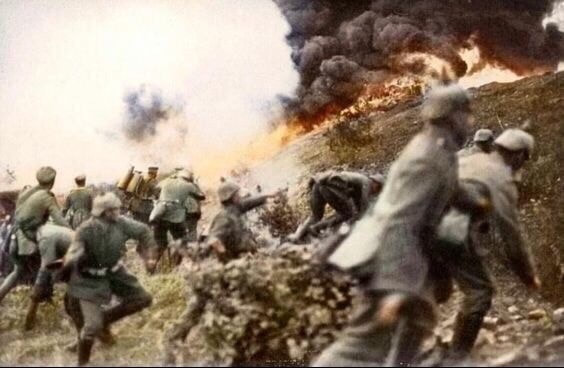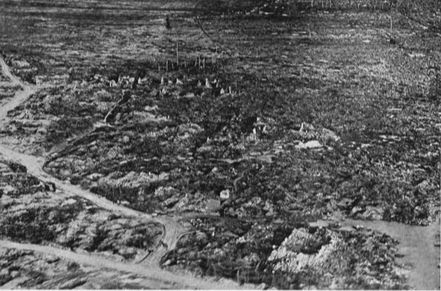They Shall Not Pass
|
On September 7th, 1918, the 79th Division was called to the front to take part in the biggest battle the US would fight until D-Day: the Meuse-Argonne Offensive.[1] By September 15th, it had relieved the French 157th Division (which included two African American divisions that had been assigned to the French) in what was renamed the Avocourt-Malancourt sector.[2] Although the Americans had been assigned the Meuse-Argonne region because it was deemed relatively quiet compared to other areas of the Western Front, that had not always been the case.
|
German Troops Assault Le Mort Homme, Verdun, 1916 (Colorized)
|
To the rear of the 79th Division was Côte 304 (Hill 304), which had seen some of the heaviest fighting during the infamous Battle of Verdun in 1916. Not far to their east was Le Mort Homme, or Dead Man's Hill, which had seen even bloodier fighting during the same battle than Côte 304. On their way to the front, the 79th had traveled along La Voie Sacrée, “the Sacred Way” that had kept the French Army alive during the German onslaught.[3] Where they were standing, with the motto "Il Nont Pas Passe" on their lips, the French had held out for over 9 months in one of the bloodiest battles in human history; it was now up to the 79th, and the rest of the AEF, to finish the job.
Formidable Terrain
|
Unfortunately for the 79th division, the 1¾ mile sector it occupied put it up against some of the best defensive ground in eastern France. The hilltop town of Montfaucon (French for “Mount Falcon”), the focal point of the division’s initial assault, was part of a ridgeline that ran north to south that had numerous draws and spurs[4] running off its east and west flanks. The spurs provided the Germans with excellent machine gun positions, as the Americans would first have to force their way up one spur, capture it, make their way down its opposite side, cross the bottom of a draw and then assault up the next spur all the while completely exposed to the enemy machine guns ahead of them.[5]
|
Terrain in Front of the 314th Regiment (Courtesy of Hathi Trust)[link]
|
While the French living in the area had cleared much of the land for farming, several large patches of woodland remained that provided excellent defensive positions for the Germans and major obstacles for the Americans. For the assault on Montfaucon, the 79th’s left flank included, from south to north, the Bois de Malancourt and the Bois de Cuisy which were separated by a triangular open area dubbed the Golfe de Malancourt. After fighting their way through the Bois de Malancourt, the Americans would find themselves caught in the Golfe with even more German machine guns dug in above them at the edge of the Bois de Cuisy. By now, most 'woods' on the Western Front were little more than fields of shattered tree trunks, but those to the front of the 79th contained both foliage and dense undergrowth. Combined with the numerous trenches, patches of barbed wire and countless muddy shell holes, the 79th’s way forward would be extremely difficult.[6]
The Hindenburg Line
|
To make matters even worse, the Germans were using their signature defense-in-depth tactics they had adopted all along the Western Front, nicknamed the Hindenburg Line. Instead of a defined defensive line, they instead used a deep defensive zone filled with numerous mutually supporting pillboxes and strong-points. These defensive tactics helped to significantly reduce the effectiveness of artillery bombardments by spacing out the defenders and made a direct assault far more difficult. Although an attack would be able to penetrate the German lines, it would soon get bogged down by mutually-supporting machine gun positions and forced to retreat by a well-timed counterattack.[1]
|
|
Many of the defenses shown in this video are in and around Montfaucon
Citations
Sample Section of the Hindenburg Line (Courtesy of Pinterest)
[1] History Committee, 79th Division Association, History of the 79th Division A.E.F. During the World War: 1917-1919, (Lancaster: Steinman & Steinman, 1922), 51. [Hathi Trust Digital Library]
[2] History Committee, 79th Division Association, History of the 79th Division A.E.F. During the World War: 1917-1919, (Lancaster: Steinman & Steinman, 1922), 57, 59. [Hathi Trust Digital Library]; Fax, 177.
[3] History Committee, 79th Division Association, History of the 79th Division A.E.F. During the World War: 1917-1919, (Lancaster: Steinman & Steinman, 1922), 55. [Hathi Trust Digital Library]
[4] Visual guide showing both a draw and a spur [Link]
[5] Fax, 193.
[6] Fax, 193-194.
[7] Editors of Encyclopaedia Britannica, “The Hindenburg Line,” Encyclopaedia Britannica, (Encyclopædia Britannica, inc., 2017); Edward G. Lengel, To Conquer Hell, (New York: Holt Paperback, 2008), 57-60.
[1] History Committee, 79th Division Association, History of the 79th Division A.E.F. During the World War: 1917-1919, (Lancaster: Steinman & Steinman, 1922), 51. [Hathi Trust Digital Library]
[2] History Committee, 79th Division Association, History of the 79th Division A.E.F. During the World War: 1917-1919, (Lancaster: Steinman & Steinman, 1922), 57, 59. [Hathi Trust Digital Library]; Fax, 177.
[3] History Committee, 79th Division Association, History of the 79th Division A.E.F. During the World War: 1917-1919, (Lancaster: Steinman & Steinman, 1922), 55. [Hathi Trust Digital Library]
[4] Visual guide showing both a draw and a spur [Link]
[5] Fax, 193.
[6] Fax, 193-194.
[7] Editors of Encyclopaedia Britannica, “The Hindenburg Line,” Encyclopaedia Britannica, (Encyclopædia Britannica, inc., 2017); Edward G. Lengel, To Conquer Hell, (New York: Holt Paperback, 2008), 57-60.


